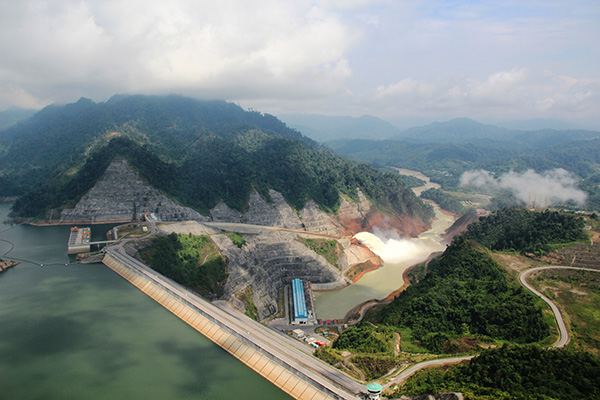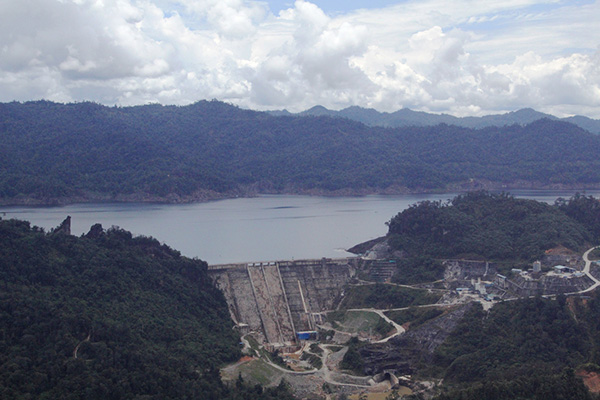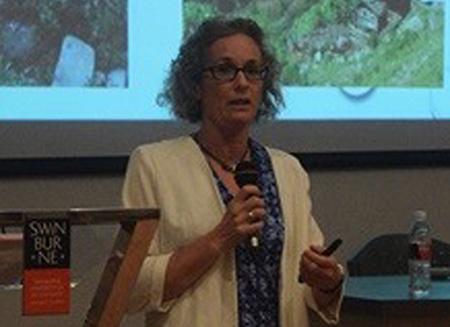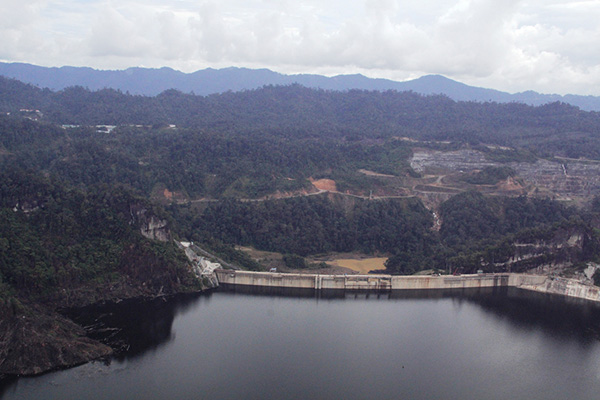
An aerial view of the Bakun HEP Dam. At 205 metres high, the Dam is Asia’s largest outside China.
EXTENSIVE commitment, good planning and execution that take into account the technical, social, economic, environmental and governance factors are key to ensuring a positive outcome for sustainable hydropower project development.
An independent consultant Dr Helen Locher, who made this observation, said good planning and execution would require not only huge monetary investments but also comprehensive groundwork that met good practices in all aspects for hydropower development to co-exist with the community and nature in a sustainable manner.
Presenting a talk on Global Perspective Of Hydropower, organised by Sarawak Energy Bhd at Swinburne University, Sarawak Campus here, she added: “The many problems facing hydropower development are mainly due to poor planning. Things are rushed through to get the project done quickly to rake in the benefits but at the expense of good impact assessment or feasibility studies to understand the development needs.”
Other reasons, she pointed out, included poor baseline information, analysis on risks, not allowing enough resources, attention and efforts into mitigating and compensating social and environmental impacts, poor regulatory frameworks, sovereign risks, corruption and lack of community acceptability.
Locher has extensive professional experience in researching and managing social and environmental issues associated with hydropower development.
She has worked for Hydro Tasmania for 18 years and previously held various top posts.
She said whether a project could meet the required standards and perform efficiently did not correlate with a developed or developing country or project size.
“Some of the keys to successful implementation and management of hydro development are about the attitude of the company and how committed the stakeholders are to ensure a successful outcome.”
She added that in practical terms, some of the things done by successful projects included ensuring the soundness of baseline information, investments in extensive studies, preparation and planning, quality management systems at all stages, good information monitoring and response, referencing international standards and good practices.
“Transparency, integrity and engagement really separate out some of these companies. This is coupled with strong corporate and public sector governance frameworks and committment by all parties, including political, regulatory and corporate, and the contractors.”
Highlighting the major obstacles, she said for all projects and companies, it was always challenging to do well with communications, and those claiming to do so had to keep investing to ensure they continued to do it well.
Other challenges she listed out were cumulative impacts which could be speculative as methods to do assessment were not very well-developed and defined while great attention was needed on mitigation, minimisation and compensation for problems related to biodiversity and ecosystem.
“In the local context (Sarawak), indigenous relations can be very sensitive and challenging, especially when the project causes big cultural transformation and change.”
According to her, every hydropower project has its individual story, context, timing while all the challenges and issues are quite unique as well.
“You can’t fit a cookie cutter to every project as it takes a lot of evaluation and tailoring. So we hope the protocol created helps provide a structured way to share the experience and practices.
“So ultimately across the globe, we hope all companies and projects will tap into some of this knowledge shared and make sure their story of project development will be very positive,” she added.

An aerial view of the Murum HEP Dam with a capacity to generate 944 megawatts of electricity. It is the third hydroelectric project in Sarawak after Batang Ai and Bakun HEPs. — Photo by Peter Sibon
Why hydropower
Hydropower, Locher said, had attracted a lot of attention and interests as an energy option because it is the largest scale renewable energy source.
It not only could contribute to climate change mitigation for both energy and water solutions but also help with water storage challenges and water management, she added.
“It’s a proven technology with a long lifespan and low operating cost and will get a lot of attention when there is a resource that can be used for energy with its concomitant advantages.”
Stressing why hydropower was still more compelling compared to other sources of renewable energy by citing Eurolectric Factsheet February 2013, recognised by the Intergovernmental Panel for Climate Change (IPCC), she said hydropower showed the highest energy payback ratio, given the amount of energy produced in the project’s lifetime relative to how much energy it took to build, operate and fuel an energy source into the commission.
“It strips ahead of others, being resource- efficient with high conversion rate from potential energy to electricity.
“It provides the most efficient storage technology because of the reservoirs, has very low levelised cost of electricity, is competitive and fully intergrated into the markets with proven long-term profitability.”
Regarding mitigation of and adaptation to climate change, Locher pointed out that hydropower had a very low carbon footprint in terms of lifecycle and green house gas emmissions.
“Moreover, it plays a really important role in promoting and enabling system stability and security of supply compared to other sources like solar and wind which are very intermittent and unpredictable due to changes in the weather.
“Hydropower can turn on and off very quickly, so it provides balance in energy, helps stabilise the grid with increasing amount of renewable energy. No other large scale energy source can do that.”
In many cases, she added, hydropower development also had various benefits to the economy, depending on the situation such as agriculture around the scheme that could potentially be used for irrigation, water supply, recreation and tourism as well as navigation.
Why not hydropower
She revealed the concerns for the development of hydropower came to the forefront of global awareness through the World Commission on Dams (WCD) which did a global review of the dam sector in the late 1990’s.
After survey schemes were carried out all over the world, WCD concluded that too often, water infrastructure projects had been developed at an unacceptable environmental or social costs.
“For example, the Hoover Dam in the US and issues connected to it, were published in The New York Times. It was criticised for the true cost of a dam but this never showed up on a balance sheet. All the nice business cases for dams were hiding the real costs to communities and the environment.
“Other key findings in the report in 2000 included failure to deliver expected benefits, delays and cost over-runs, loss of forests and biodiversity, failure to mitigate measures, cumulative impacts, population displacement, livelihoods adversely affected, lack of compensation, and inequitable distribution of benefits,” she said.
Besides, Locher added, there were many other possible issues unique to the specific project as well, including high upfront costs.
“Many projects can suffer cost and time blow-outs, lack of access to basic services like transport, education and health, corruption, transparency in procurement process and much more.”
To address the realsustainability challenges, she stressed projects must be carefully considered and balanced to demonstrate hydropower development was a good investment overall for society and communities.
“We want to maximise the positive contributions that cannot be taken for granted.
“With careful choices, planning, designs and accompanied by measures, we can get a lot more values out of the project,” she said, adding that this included regional development, poverty alleviation, other services and multi-purpose projects.

Locher highlighting some of the key issues affecting the development of hydropower dams.
According to protocol
Locher noted after 30 years, the industry knew a lot better now, especially in avoiding the “very alarming problems.”
“The industry has learnt how to plan, design, build and operate better hydro projects — with the means to get better projects with the World Bank Safeguards, International Energy Agency Guidelines, WCD priorities and core values, and the Hydropower Sustainability Assessment Protocol.
“So we know much better now what a good project is. It’s much better documented, understood and shared.”
Locher was the coordinator of the Hydropower Sustainability Assessment Forum between 2008 and 2010 which saw the development of the 2010 Hydropower Sustainability Assessment Protocol.
The protocol is a framework to assess sustainability at all stages of project implementation and is a consistent globally applicable methodology.
“The WCD Final Report in 2000 has led to the development of Sustainability Guidelines by the International Hydropower Association (IHA) where the industry acknowlegded the many issues involved and that best practices needed to be promoted.
“This was followed by the development of the protocol launched in 2011. The protocol is an assessment tool for project lifecycle stages from early stage (an idea) to preparation, implementation and operation to ensure the project meets the basic best practices,” she explained.
The four-document protocol covers 20-23 topics focusing on the perspectives of integrative, environmental, social, technical, economic and financial which is individually scored from a grade of 1 to 5 with 5 being proven best practices.
“The scoring is based on criteria, including assessment, management, stakeholder engagement, stakeholder support, conformance and compliance and positive outcomes,” she said.
However, she pointed out that not every criterion applied to every topic as some could be more applicable to others and then there were the cross cutting issues that needed to be assessed, particularly relating to human rights, climate change, transboundary issues, and so on.
“So the minimum is that every project should be able to achieve a grade 3 which is basic good practice,” she said, adding that the idea was to drive continuous improvement as assessment could highlight the opportunities.
She shared that the Murum Hydropower Dam under the Sarawak Energy, was among the early participants following the protocol up till the implementation stage and had been undertaking assessment and getting training since 2012.
What to watch out for
She said the technical considerations included ensuring hydrological resource availability and reliability, infrastructure safety, slope stability, natural hazards, community safety and emergency response.
For example, she added, for the 456 MW Chaglia Hydropower Project in Peru, there were a lot of risks issues like overtopping, landslides, road accidents, erosions, and different type of failures.
“So they chose to follow international standards laid out by the International Commission of Large Dams (ICOLD).
“They implemented quality procedures in the dam construction to ensure no weaknesses in every step and process. They also used independent experts panel on dam safety.”
For economic considerations, the protocol picks up and focuses on the demonstration of net economic benefit, equitable distribution and sharing of benefits as well as attention on local capacity building.
“The 3,750 MW Jirau Hydropower Project in Brazil is one example that went quite some lengths on ensuring good economic contributions to the region beyond just the basics.
“It’s a very large project in a remote and undeveloped region so the government made sure they lifted the region as it was a very significant project. So they committed to making sure 70 per cent of the employees were from the region. At peak, there were 25,000 employees,” she noted.
Locher stressed that with environmental considerations, there were many aspects that really needed close attention as the fundamentals could change with the project, including water quality, erosion, sedimentation and geomorphic change as well as many biodiversity risks to terrestrial and aquatic flora and fauna, impacts to species abundance and diversity, and habitat loss.
As social considerations could arise, depending on the location of the project and nature of the community, Locher highlighted the need to address population and economic displacement, vulnerable social groups, cultural values and heritage, indigenous peoples, community engagement and acceptance, livelihood impacts, social compensation, benefit sharing, public health risks and access to basic services like transport, education, health and electricity.
“One good example is the 1,240 MW Salto Caxias Hydropower Project in Brazil (name has since been changed) where 25 per cent of the dam’s $1 billion cost was involved in a resettlement programme for the 1,000 families displaced by the reservoir,” she said.
“The community plays a huge part in its design and decisions which could be one of the secrets to its success. After resettlement, it ensures the delivery of everything that were needed, problems were managed and outcomes were good.”
Governance is one area the protocol covers.
Locher said the assessment would see how well the project fitted in with regional strategies and plans, public sector and corporate governance frameworks, risks management, compliance and meeting commitments, ethics and anti-corruption as well as equitable and transparent procurement processes.
“The 720 MW Mangdechhu Hydropower Project in Bhutan is one such project that strongly emphasised in procurement processes where they had all the contractors sign the integrity pacts,” she said.
“What was really striking was they had information for bidders in contracts with a list of detailed definitions for corruption, collusion, coercion, restrictive practices, inappropriate practices, fraudulent practices and so on. They really put in a lot attention and highlighted what exactly they were talking about,” she said.

The resevoir around the Murum Dam can help with water storage challenges and water management. — Photo by Peter Sibon
